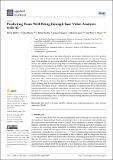| dc.contributor.author | Müller, Moritz | |
| dc.contributor.author | Dupuis, Ambre | |
| dc.contributor.author | Zeulner, Tobias | |
| dc.contributor.author | Vazquez, Ignacio | |
| dc.contributor.author | Hagerer, Johann | |
| dc.contributor.author | Gloor, Peter A. | |
| dc.date.accessioned | 2024-02-09T17:39:09Z | |
| dc.date.available | 2024-02-09T17:39:09Z | |
| dc.date.issued | 2024-02-03 | |
| dc.identifier.uri | https://hdl.handle.net/1721.1/153483 | |
| dc.description.abstract | Well-being is one of the pillars of positive psychology, which is known to have positive effects not only on the personal and professional lives of individuals but also on teams and organizations. Understanding and promoting individual well-being is essential for staff health and long-term success, but current tools for assessing subjective well-being rely on time-consuming surveys and questionnaires, which limit the possibility of providing the real-time feedback needed to raise awareness and change individual behavior. This paper proposes a framework for understanding the process of non-verbal communication in teamwork, using video data to identify significant predictors of individual well-being in teamwork. It relies on video acquisition technologies and state-of-the-art artificial intelligence tools to extract individual, relative, and environmental characteristics from panoramic video. Statistical analysis is applied to each time series, leading to the generation of a dataset of 125 features, which are then linked to PERMA (Positive Emotion, Engagement, Relationships, Meaning, and Accomplishments) surveys developed in the context of positive psychology. Each pillar of the PERMA model is evaluated as a regression or classification problem using machine learning algorithms. Our approach was applied to a case study, where 80 students collaborated in 20 teams for a week on a team task in a face-to-face setting. This enabled us to formulate several hypotheses identifying factors influencing individual well-being in teamwork. These promising results point to interesting avenues for research, for instance fusing different media for the analysis of individual well-being in teamwork. | en_US |
| dc.publisher | Multidisciplinary Digital Publishing Institute | en_US |
| dc.relation.isversionof | http://dx.doi.org/10.3390/app14031284 | en_US |
| dc.rights | Creative Commons Attribution | en_US |
| dc.rights.uri | https://creativecommons.org/licenses/by/4.0/ | en_US |
| dc.source | Multidisciplinary Digital Publishing Institute | en_US |
| dc.title | Predicting Team Well-Being through Face Video Analysis with AI | en_US |
| dc.type | Article | en_US |
| dc.identifier.citation | Applied Sciences 14 (3): 1284 (2024) | en_US |
| dc.contributor.department | Massachusetts Institute of Technology. Center for Collective Intelligence | |
| dc.contributor.department | System Design and Management Program. | |
| dc.identifier.mitlicense | PUBLISHER_CC | |
| dc.eprint.version | Final published version | en_US |
| dc.type.uri | http://purl.org/eprint/type/JournalArticle | en_US |
| eprint.status | http://purl.org/eprint/status/PeerReviewed | en_US |
| dc.date.updated | 2024-02-09T15:06:53Z | |
| dspace.date.submission | 2024-02-09T15:06:53Z | |
| mit.license | PUBLISHER_CC | |
| mit.metadata.status | Authority Work and Publication Information Needed | en_US |
